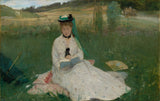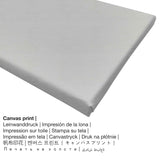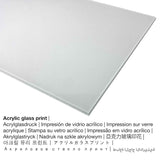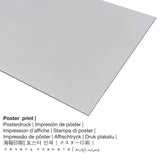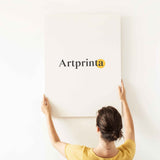Berthe Morisot, 1873 - Ọgụgụ - mbipụta nka mara mma
Ụtụ gụnyere. Mbupu gbakọrọ na ndenye ọpụpụ.
Ozi ndabere na ihe nka ihe karịrị afọ 140
Nke a karịrị 140 afọ eserese Reading onye na-ese ihe sere ya Berthe Morisot. Ụdị mbụ nke ọmarịcha ihe na-atụ nha - Nhazi: 74,3 x 100,3 x 12,1 cm (29 1/4 x 39 1/2 x 4 3/4 na); Edebereghị: 46 x 71,8 cm (18 1/8 x 28 1/4 na). Mmanụ na akwa ákwà was used by the painter as the medium of the artpiece. The masterpiece has the following text as inscrption: "signed lower right: [black:] B [in red:] erthe M[in black:] orisot Remnants of a signature lower left: B". Moveover, this artpiece is in the the Ụlọ ihe ngosi nka nke Cleveland nchịkọta dijitalụ. Site n'ikike nke: Velọ ihe ngosi nka nke Cleveland (license - public domain). : Gift of the Hanna Fund. Besides this, the alignment of the digital reproduction is landscape with a ratio of 3 : 2, which implies that ogologo bụ 50% ogologo karịa obosara. Berthe Morisot was a female painter from France, whose art style can be attributed primarily to Impressionism. The artist lived for 54 afọ - a mụrụ n'afọ 1841 in Bourges, Centre region, France and passed away in the year 1895.
Nye iwu ngwaahịa ọkacha mmasị gị
In the dropdown menu next to the product offering you can choose your individual size and material. The following options are available for individualization:
- Metal (aluminium debond mbipụta): Aluminium Dibond prints are prints on metal with an impressive effect of depth, which creates a contemporary impression throuch a non-reflective surface structure. The bright parts of the work of art shimmer with a silk gloss, however without any glare.
- Akwụkwọ mmado ebipụtara (akwa akwa akwa): A poster is a printed canvas paper with a slightly rough finish on the surface, that resembles the original artwork. Please bear in mind, that depending on the size of the canvas poster print we add a white margin of around 2-6cm round about the painting to facilitate the framing with a custom frame.
- Mbipụta kwaaji: The canvas print is a printed canvas mounted on a wood frame. A canvas makes the special effect of three-dimensionality. Your canvas of your favorite artwork will let you turn your own into a large artwork. Canvas prints are relatively low in weight. This means, it is quite simple to hang up your Canvas print without additional wall-mounts. A canvas print is suitable for any type of wall.
- Mbipụta iko acrylic (nke nwere ezigbo mkpuchi iko): A glossy print on acrylic glass, which is sometimes named as a plexiglass print, will transform your favorite original artwork into stunning décor. Our plexiglass with real glass coating protects your custom fine art print against light and heat for between four and six decades.
Nkwupụta iwu: We try what we can to describe our art products as precisely as possible and to display them visually on the product detail pages. Although, the pigments of the printing material and the imprint might diverge slightly from the image on your device's screen. Depending on your settings of your screen and the quality of the surface, colors may not be printed as exactly as the digital version on this website. In view of the fact that all the are processed and printed by hand, there might also be slight discrepancies in the motif's exact position and the size.
Ozi ederede ahaziri
| Ụdị edemede: | ọrụ mgbidi |
| Mmeputakwa: | dijitalụ mmeputakwa |
| Produzọ mmepụta: | Mbipụta UV ozugbo |
| Nlụpụta: | German mmepụta |
| Ụdị ngwaahịa: | na mmepụta ihe |
| Ngwaahịa were: | mgbidi mgbidi, foto mgbidi |
| Ntuziaka onyonyo: | nhazi odida obodo |
| Oke akụkụ onyonyo: | 3: 2 (ogologo: obosara) |
| Akụkụ akụkụ pụtara: | ogologo bụ 50% ogologo karịa obosara |
| Nhọrọ akụrụngwa: | ígwè obibi akwụkwọ (aluminium dibond), akwụkwọ mmado (akwụkwọ kwaaji), mbipụta enyo acrylic (nke nwere ezigbo mkpuchi iko), mbipụta akwụkwọ. |
| Mpempe akwa akwa (akwa akwa na etiti ihe ndọtị) nha: | 30x20cm - 12x8", 60x40cm - 24x16", 90x60cm - 35x24", 120x80cm - 47x31", 150x100cm - 59x39" |
| Acrylic glass print (nwere ezigbo mkpuchi iko) nhọrọ: | 30x20cm - 12x8", 60x40cm - 24x16", 90x60cm - 35x24", 120x80cm - 47x31", 150x100cm - 59x39" |
| Mpempe akwụkwọ mmado (akwụkwọ kwaaji) nha dị iche iche: | 60x40cm - 24x16", 90x60cm - 35x24", 120x80cm - 47x31" |
| Mpempe akwụkwọ Dibọn (ihe alumnium): | 30x20cm - 12x8", 60x40cm - 24x16", 90x60cm - 35x24", 120x80cm - 47x31" |
| Igwe onyonyo: | adịghị |
Nkọwa na ọrụ nka pụrụ iche
| Aha nka: | "Ịgụ" |
| Nchịkọta nke ọrụ nka: | sere |
| Okwu mkpokọta: | nkà nke oge a |
| Century: | 19th narị afọ |
| Afọ nka: | 1873 |
| Afọ nka: | ihe karịrị afọ 140 |
| Ihe osise izizi: | mmanụ na akwa ákwà |
| Akụkụ ihe osise izizi: | Nhazi: 74,3 x 100,3 x 12,1 cm (29 1/4 x 39 1/2 x 4 3/4 na); Edebereghị: 46 x 71,8 cm (18 1/8 x 28 1/4 na) |
| Akara mbinye aka: | signed lower right: [black:] B [in red:] erthe M[in black:] orisot Remnants of a signature lower left: B |
| Ụlọ ihe ngosi nka: | Velọ ihe ngosi nka nke Cleveland |
| Ebe ngosi nka: | Cleveland, Ohio, United States nke America |
| Ebe nrụọrụ weebụ ihe ngosi nka: | www.clevelandart.org |
| Ụdị nka nka: | ngalaba ọha |
| Site n'aka: | Velọ ihe ngosi nka nke Cleveland |
| kreditline ọrụ nka: | Onyinye ego Hanna |
Tebụl onye na-ese ihe
| Aha onye nka: | Berthe Morisot |
| Aliases: | Berthe Marie Pauline Morisot, B. Morisot, Morisot, Morisot, Berthe Morisot, Morisot Berthe-Marie-Pauline, Morisot, Morisot Berthe Marie Pauline, Morisot Berthe Marie Pauline, Morisot Berthe Manet, Manet Berthe Marie Pauline Morisot |
| okike nke onye nka: | nwanyi |
| Nationality: | French |
| Ọrụ: | onye na-ese ihe |
| Obodo onye nka: | France |
| nhazi ọkwa: | omenkà nke oge a |
| Ụdị nka: | Mmetụta |
| Akwụsị: | 54 afọ |
| Afọ ọmụmụ: | 1841 |
| Ebe amụrụ onye: | Bourges, mpaghara Center, France |
| Nwụrụ n'afọ: | 1895 |
| Obodo ọnwụ: | Paris, Ile-de-France, France |
© echebe nwebiisinka - Artprinta (www.artprinta.com)
Nkọwa ihe osise izizi sitere na ụlọ ngosi nka (© - Ụlọ ihe ngosi nka nke Cleveland - Velọ ihe ngosi nka nke Cleveland)
The fashionable woman seated in the foreground is the artist's sister, Edma. However, the painting is not a portrait. Morisot's principal concern was to render a figure in a natural, outdoor environment. Edma's white dress-the prime vehicle for Morisot's study of reflected light-is saturated with delicate lavender, blue, yellow, and rose tonalitites. Deftly executed with quick brushstrokes, the painting resounds with a feeling of freshness, vibrancy and delicate charm. "Every day I pray that the Good Lord will make me like a child," Morisot wrote, "That is to say, that He will make me see nature and render it the way a child would, without preconceptions." Morisot, the great granddaughter of the 18th-century French painter Jean-Honoré Fragonard, selected this painting as one of her four works shown in the first Impressionist exhibition of 1874.

